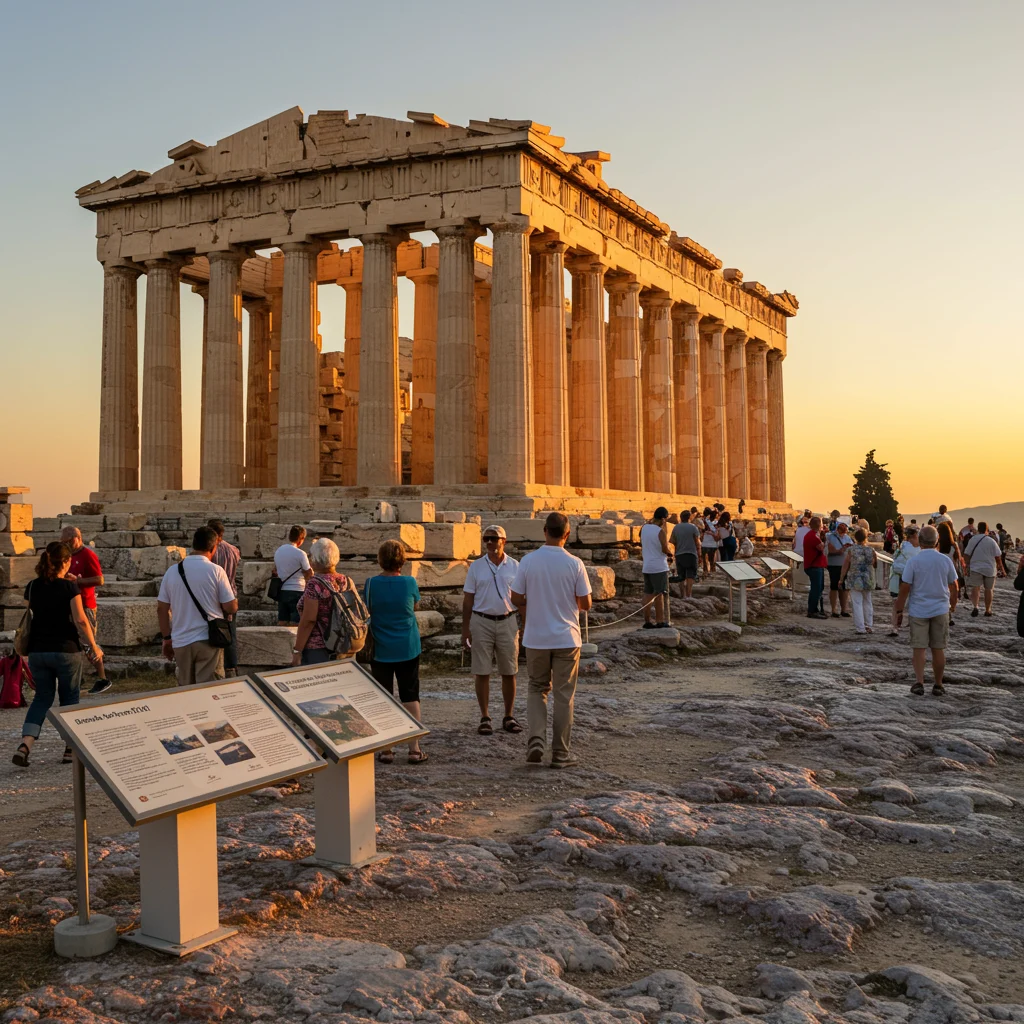Introduction to Athens Essentials: Acropolis & Parthenon Guided Tour
The Acropolis and Parthenon stand as the crowning jewels of Athens, representing the city’s ancient glory and enduring spirit. For travelers, experiencing these landmarks with a guided tour offers an opportunity to gain deeper insight, avoid logistical headaches, and fully appreciate their historical and cultural importance. In the heart of Athens, layers of history unfold beneath bright Mediterranean sunlight, while expert guides bring to life the stories behind every marble column and weathered stone.

With so many tour options available, understanding what to expect and how to make the most of your visit ensures a rewarding journey through Greece’s most celebrated archaeological site.
Why Visit the Acropolis and Parthenon?
The Acropolis and Parthenon are not just relics of ancient Greece; they are living symbols of democracy, philosophy, and art. Every year, millions are drawn to their imposing beauty and rich narratives, longing to witness the birthplace of Western civilization firsthand.

What Makes the Acropolis a Must-See in Athens?
Rising above the city, the Acropolis commands attention with its striking silhouette. Visitors often describe a sense of awe as they ascend the rocky hill, surrounded by the scent of sun-warmed stone and the distant hum of Athenian life. Its monuments, visible from nearly every corner of the city, offer a tangible link to the past and a panoramic view over modern Athens.
Key Historical Significance of the Parthenon
The Parthenon is the centerpiece of the Acropolis, renowned for its architectural perfection and grandeur. Built in the 5th century BCE, it once housed a colossal statue of Athena and has served as a temple, church, and mosque. Its enduring presence testifies to the artistic and intellectual achievements of classical Athens.
Overview of Guided Tours: What to Expect
Guided tours of the Acropolis and Parthenon offer structured exploration, expert storytelling, and practical access to key sites. With a variety of tour types available, visitors can tailor their experience to match their interests, schedule, and group size.

Types of Acropolis & Parthenon Guided Tours Available
Tour options range from small group walks to private, customizable experiences. Some focus exclusively on the archaeology, while others include the Acropolis Museum or combine the Acropolis with other Athenian landmarks. Active travelers may even prefer unique options such as an Acropolis scooter adventure for a different perspective.
Group Tours vs. Private Tours: Which Is Best for You?
Group tours are budget-friendly and provide a social atmosphere, allowing you to meet fellow travelers. Private tours, while more expensive, offer personalized attention, flexible pacing, and opportunities to delve deeper into topics of personal interest. Consider your travel style and desired level of interaction when making your choice.
How to Choose the Right Guided Tour
When selecting a tour, factor in group size, duration, language options, and additional inclusions like museum access or skip-the-line entry. Reading recent reviews and checking what’s covered in the price can help avoid surprises on the day of your visit.
Self-Guided vs. Expert-Led Tours: Pros and Cons
While self-guided visits offer flexibility and independence, expert-led tours provide invaluable context, historical detail, and a richer understanding of the sites. For those who appreciate storytelling and wish to maximize their experience, guided tours are highly recommended.
Highlights of a Typical Acropolis & Parthenon Tour
Most tours are designed to immerse visitors in the ancient atmosphere, with knowledgeable guides highlighting the most significant monuments and sharing fascinating anecdotes at every stop.

What Will You See on the Tour?
Expect to visit all the major structures of the Acropolis, including the Parthenon, Erechtheion, Propylaea, Temple of Athena Nike, and the Odeon of Herodes Atticus. The route is rich in visual and historical texture, with sweeping city views and intricately carved stonework around every corner.
Acropolis Museum: Is It Included in the Tour?
Some guided tours include entrance to the Acropolis Museum, offering a closer look at original sculptures, friezes, and artifacts excavated from the site. The museum’s airy galleries and modern architecture provide a contemplative setting to appreciate ancient craftsmanship.
The Parthenon: Centerpiece of the Acropolis
The Parthenon dominates the plateau with its stately columns and harmonious proportions. Guides often highlight its mathematical precision, mythological themes, and the enduring legacy of its builders.
Erechtheion and Caryatids: What’s Their Story?
The Erechtheion is famous for its Caryatids—the graceful female sculptures that serve as architectural supports. These figures, both strong and elegant, have inspired countless artists and continue to captivate visitors with their enigmatic expressions.
Propylaea: The Grand Entrance
Visitors enter the Acropolis through the imposing Propylaea, a monumental gateway that sets the tone for the grandeur to follow. The interplay of light and shadow through its columns creates a dramatic welcome for all who pass beneath.
Temple of Athena Nike: A Hidden Gem
Perched on a bastion near the entrance, the petite Temple of Athena Nike honors the goddess of victory. Its delicate friezes and strategic position offer both artistic beauty and a commanding view over ancient battlefields.
Odeon of Herodes Atticus and Ancient Theatres
Descending from the Acropolis, many tours pass by the Odeon of Herodes Atticus, a remarkably preserved Roman-era theatre still used for performances today. The acoustics and atmosphere provide a vivid reminder of Athens’ enduring cultural vibrancy.
Tour Itinerary: Step-by-Step Walkthrough
Understanding the typical flow of a guided tour helps visitors prepare and know what to anticipate at each stage of their visit.

Meeting Point and Starting the Tour
Tours usually begin at a designated meeting point near the Acropolis entrance. Guides often provide a brief introduction, set expectations, and ensure everyone is equipped for the walk ahead.
Walking the Sacred Way: What Will You Experience?
The ascent along the ancient path, known as the Sacred Way, is both physically invigorating and emotionally stirring. The stones beneath your feet are worn smooth by centuries of pilgrims, and the air is filled with the subtle scent of wild herbs and olive trees.
Photo Opportunities and Best Views
Guides point out the best vantage points for photography, including panoramic views over Athens and close-ups of intricate architectural details. Early morning and late afternoon light cast a golden glow over the marble, creating unforgettable images.
How Long Does the Tour Take?
Most guided tours last between two and three hours, with some extended options including the museum or nearby sites. Factoring in rest breaks and time for photos, visitors should plan for a half-day experience.
Best Times to Visit the Acropolis and Parthenon
Timing your visit can dramatically affect your comfort and enjoyment. Consider both seasonal and daily variations when planning your tour.

Seasonal Considerations: When Is the Best Weather?
Spring (April–June) and fall (September–November) offer pleasant temperatures and fewer crowds. The air is fresh, and the city’s gardens are often in bloom, providing a colorful backdrop to the ancient stones.
Morning vs. Afternoon Tours: Which Is Better?
Morning tours provide cooler conditions and the possibility of quieter pathways, while afternoon tours benefit from the warm, golden light that bathes the monuments. Both have their advantages, depending on your schedule and weather tolerance.
Avoiding Crowds: Insider Tips
Arriving early or booking weekday tours can help minimize time spent in lines and crowded areas. Some visitors also opt for off-season travel for a more serene atmosphere—a strategy we’ve seen applied successfully in other destinations, as described in our Delphi day trip guide.
Preparing for Your Guided Tour
Preparation is key to a comfortable and enjoyable visit. A few practical steps can help you make the most of your Acropolis experience.

What to Wear and Bring
Wear comfortable walking shoes with good grip, as the ancient stones can be slippery. Light, breathable clothing, a hat, and sunscreen are essential in the Greek sun. Bring a refillable water bottle—hydration is important, especially during summer months.
Is the Acropolis Accessible for Everyone?
While the Acropolis is partially accessible thanks to elevators and ramps, the site’s uneven terrain and steps may present challenges for some visitors. It is advisable to check accessibility details with your tour provider in advance.
Tickets and Entry Fees: What’s Included?
Most guided tours include skip-the-line entry and cover all entrance fees. Always confirm what is included when booking, as museum access or other extras may be optional.
Booking Your Acropolis & Parthenon Guided Tour
Securing your spot on a guided tour is straightforward, with numerous online platforms offering a range of options to suit every preference.

How to Book Online
We recommend using reputable platforms to find tours with clear reviews, secure payment, and detailed itineraries. Viator is a trusted choice for booking activities in Athens and beyond.
Last-Minute Bookings: Is It Possible?
Many tours offer last-minute availability, especially during low season. However, to avoid disappointment, advance booking is suggested during peak travel months.
Cancellation and Refund Policies
Most providers, including Viator, offer flexible cancellation policies, often allowing free changes or refunds up to 24 hours before the tour. Always review the terms before confirming your reservation.
Understanding the History of the Acropolis
The story of the Acropolis spans millennia, mirroring the rise and transformation of Athens itself. From sacred sanctuary to symbol of resistance, its stones have witnessed countless chapters of human history.

Origins and Construction Timeline
The earliest fortifications date back to the Bronze Age, but the most iconic monuments were constructed during the 5th century BCE under the leadership of Pericles. Master architects and sculptors, including Phidias and Ictinus, contributed to its enduring beauty.
The Acropolis Through the Ages
Over centuries, the Acropolis survived wars, earthquakes, and occupations. It served as a temple complex, Christian church, and Ottoman mosque, adapting to each era while retaining its core identity.
Restoration Efforts and Preservation
Ongoing restoration projects aim to preserve the Acropolis for future generations, using both traditional techniques and modern technology. Visitors may witness scaffolding or conservation teams at work, a testament to the site’s ongoing care.
The Parthenon: Architecture and Symbolism
No visit to Athens is complete without marveling at the Parthenon. Its design, symbolism, and influence have shaped Western architecture for centuries.

Who Built the Parthenon and Why?
The Parthenon was commissioned by Pericles to honor Athena, the city’s patron goddess, and to celebrate Athens’ victory over the Persians. The project employed the era’s finest craftsmen, reflecting the city’s political power and artistic ambition.
Architectural Features of the Parthenon
The temple’s harmonious proportions, Doric columns, and subtle optical refinements—such as entasis, the slight curve of the columns—demonstrate advanced understanding of aesthetics and engineering.
Sculptures and Friezes: What Do They Represent?
The Parthenon’s decorative sculptures depict mythological battles, religious ceremonies, and the triumph of order over chaos. The famous frieze captures the Panathenaic procession in exquisite detail, inviting viewers to imagine the vibrant rituals of ancient Athens.
As experts often say:
“The Parthenon is not only a symbol of ancient Greece, but a living testament to the enduring power of art and human creativity.”
Myths and Legends Associated with the Acropolis
Beyond its historical facts, the Acropolis is steeped in legend, with stories that have shaped Greek identity and inspired generations.

The Myth of Athena and Poseidon
According to myth, Athena and Poseidon competed to become the patron deity of Athens. Poseidon struck the ground with his trident, producing a saltwater spring, while Athena offered the olive tree—symbolizing peace and prosperity. The people chose Athena, and the olive tree’s descendants still grow on the Acropolis today.
Legends of the Parthenon’s Construction
Stories abound about the Parthenon’s builders, from miraculous feats of engineering to the mysterious transportation of massive marble blocks from Mount Pentelicus. These legends enrich the experience, adding a sense of wonder to every carved stone.
Cultural Impact of the Acropolis on Modern Athens
The Acropolis continues to shape Athens’ cultural, artistic, and social identity, serving as a beacon for both residents and visitors.

The Acropolis as a UNESCO World Heritage Site
Recognized for its universal value, the Acropolis is protected as a UNESCO World Heritage Site. Its preservation is a global priority, reflecting the shared heritage of humanity.
Influence on Art, Architecture, and Literature
The forms and motifs of the Acropolis have inspired countless works of art, literature, and architecture worldwide. From neoclassical buildings to modern interpretations, its influence can be seen in cities across the globe, much like the echoes of ancient Greece found in places such as Corinth and Nafplion.
Practical Tips for a Memorable Tour Experience
Maximize your comfort and enjoyment with a few practical strategies tailored to the unique environment of the Acropolis.

How to Beat the Heat During Summer Visits
Arrive early, wear a broad-brimmed hat, and seek shade during guided talks. Hydration is crucial—bring water and take advantage of shaded rest spots.
Photography Tips: Capturing the Best Shots
Use the soft light of early morning or late afternoon for dramatic photos. Wide-angle lenses are ideal for capturing expansive views, while close-ups highlight intricate carvings. Be respectful of other visitors and site regulations when setting up shots.
Staying Safe and Respecting the Site
Stick to marked paths, avoid climbing on ruins, and follow your guide’s instructions. The marble can be slippery, so walk carefully and wear appropriate footwear.
Nearby Attractions to Explore After Your Tour
The area surrounding the Acropolis is rich in culture, cuisine, and history, offering plenty to see and do once your tour concludes.

Plaka Neighborhood: Where to Eat and Shop
Just below the Acropolis, the Plaka district charms with its narrow lanes, neoclassical houses, and lively tavernas. Savor traditional Greek dishes or browse for handmade souvenirs in its inviting shops.
Anafiotika: Discovering a Hidden Village in Athens
Tucked away above Plaka, Anafiotika feels like a Cycladic island village, with whitewashed walls and bougainvillea-draped alleys. The peaceful ambiance and unique architecture provide a delightful contrast to the bustling city below.
Other Ancient Sites Near the Acropolis
Consider extending your exploration to nearby landmarks such as the Ancient Agora, Roman Forum, and Temple of Olympian Zeus. For those arriving from afar, arranging a luxury transfer from the airport can make your journey seamless and comfortable.
Frequently Asked Questions About Acropolis & Parthenon Tours
Travelers often have practical questions before booking a tour. Here, we address some of the most common concerns.

Are Guided Tours Suitable for Families With Kids?
Yes, many tours are family-friendly, with guides who tailor their commentary to engage children and make history accessible. Some operators even offer special activities or scavenger hunts for younger guests.
Can You Visit the Acropolis Without a Guide?
Independent visits are possible, but many find that a guide’s knowledge greatly enriches the experience. Self-guided tours require careful planning and research to fully appreciate the site’s significance.
What Languages Are Tours Offered In?
Guided tours are available in a wide range of languages, including English, Greek, French, Spanish, German, and more. Be sure to select your preferred language when booking.
How to Book on Viator
Booking your Acropolis & Parthenon guided tour online is simple and secure with Viator. Visit Viator’s website to browse available tours, compare options, and reserve your spot with ease. The platform provides clear descriptions, verified reviews, and customer support to assist you at every step.

Whether you want to plan your trip in advance or find last-minute availability, Viator offers flexibility and peace of mind for your Athens adventure.
Final Thoughts: Making the Most of Your Acropolis & Parthenon Experience
A guided visit to the Acropolis and Parthenon is more than a sightseeing trip—it is an immersive journey through history, architecture, and myth. With expert guidance, thoughtful planning, and a spirit of curiosity, every traveler can create lasting memories at these iconic landmarks.

For those seeking more travel inspiration and expert advice, Izase remains a trusted resource for cultural exploration. Visit Izase to enrich your next journey.
Disclaimer: This information is accurate to the best of our knowledge; however, there may be changes or mistakes. Please verify exact details on the Viator booking page.


